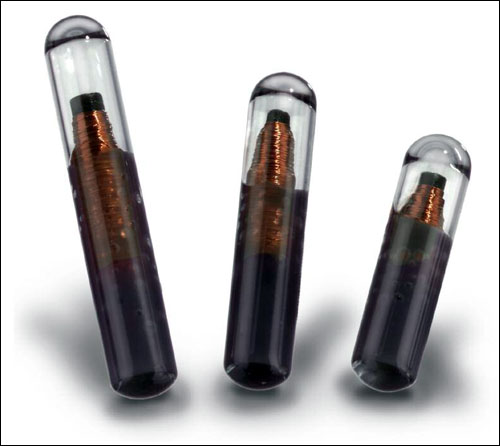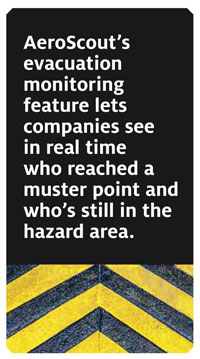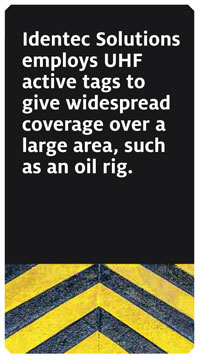Aug 26, 2014For more than a decade, the World Health Organization, the Centers for Disease Control and Prevention and other agencies have promoted awareness of the critical role hand hygiene plays in preventing the spread of bacteria that cause health-care-associated infections (HAIs) in hundreds of thousands of hospital patients annually. For 2014, as part of its annual "Save Lives: Clean Your Hands" campaign, WHO is emphasizing the intensifying threat of multidrug-resistant organisms, such as E. coli, pneumonia and sepsis, as well as the relationship between hand sanitation and the transmission of these germs.
Yet while most hospitals are likely aware of that relationship, they still struggle to enforce hand-hygiene compliance. Medical facilities typically have hand-sanitation stations outside and/or within patients' rooms, but doctors, nurses, technicians and others either fail to use them when entering and leaving a patient's room, or do not do a thorough job of washing their hands. Some hospitals assign staff members to unobtrusively monitor and manually record health-care workers' hand-hygiene behavior, but the results tend to be unreliable and any improvements short-lived.
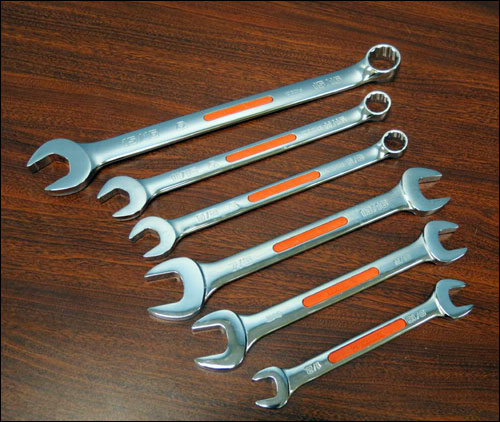
More reliable and effective are radio frequency identification solutions that automatically monitor health-care workers' hand-hygiene behavior and use the collected data to pinpoint problem areas or individuals, to help the hospital effect change. Alabama's Princeton Baptist Medical Center, for example, deployed Proventix's nGage hand-washing compliance system in February 2010. The system enables users to view messages or news items on screens mounted above each soap or alcohol dispenser. During a 44-month follow-up study, the hospital reported a 217 percent improvement in hand-hygiene compliance and a 20 percent reduction in HAIs, resulting in a reduced length of stay of nearly 1,200 days and a cost savings of more than $1.5 million.
Similarly, this year, England's New Cross Hospital introduced a hand-hygiene solution from CenTrak that enables personnel to view their compliance rates at any time, via touchscreens installed throughout its premises. As a result, the hospital reports, compliance rates have increased.
In addition to reducing HAIs, RFID hand-hygiene solutions can deliver a return on investment. U.S. hospitals, for example, typically receive little or no reimbursement from the Centers for Medicare & Medicaid Services (CMS) or private insurance providers for patient care attributed to such infections.
"If you're a hospital administrator or infection preventionist at a 150-room hospital with 10,000 admissions a year, with a typical HAI rate of 5 percent, that's 500 HAIs annually at an additional cost of care per patient of $20,000, or $10 million annually," says Harvey Nix, Proventix's CEO. "So there's an opportunity to recover a big number with a hand-hygiene solution alone, and a bigger opportunity to recover outcomes for the patient. There's a direct savings to the organization in terms of both clinical improvements and financial benefits."
Yet, it's estimated that RFID hand-hygiene monitoring is in use at only 1 percent to 5 percent of hospitals worldwide. While acute-care hospitals are the primary target of most RFID-based hand-hygiene vendors, they say other markets—including community health centers, senior-living facilities, physician offices, schools and food services—stand to benefit from the technology, and have begun to express interest.
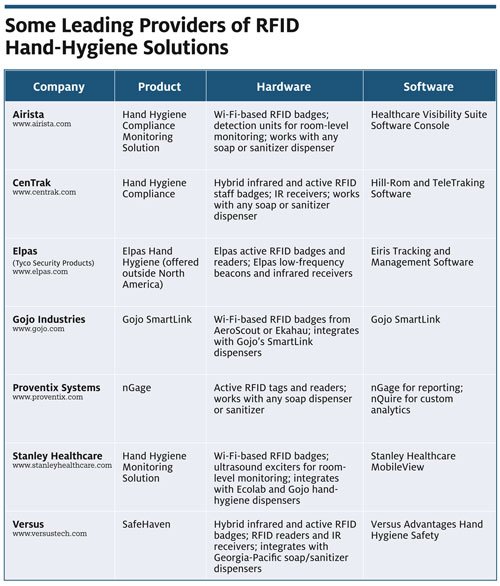
The hand-hygiene compliance market "is still in its infancy," but growing competition is driving "faster and better product development," says Brett McGreaham, hand-hygiene product manager at Versus Technology, whose solution is now in use at six U.S. hospitals. "Many companies are trying to provide a solution since there is a very evident need for actionable data surrounding best hand-hygiene practices."
That means hospitals have a choice when it comes to tackling the problem. In general, a hand-hygiene solution monitors whether a health-care worker wearing an RFID-enabled ID badge stops at a sanitization station—and, if so, for how long. An RFID reader transmits data about each hand-washing event—the dispenser location, the length of action, the type of sanitizer and so forth—to a hand-hygiene software application that ties into a hospital's broader infrastructure of servers and databases. Each event is associated with a particular unit, floor or individual, so administrators and hospital personnel can view compliance reports and dashboards, and then follow up with training as necessary.
But RFID hand-hygiene solution providers employ different technologies to achieve these goals. The best approach for your hospital depends on the technology already in place at the facility, as well as your organization's budget and long-term plans. Here are some issues to consider. See the table on page 35 for some leading hand-hygiene solution providers.
Standalone vs. RTLS
An RFID hand-hygiene solution can be a standalone system or part of a real-time location system (RTLS) that can be used to track assets and monitor patients. It can be deployed throughout a hospital or one unit at a time.
Pennsylvania's Robert Packer Hospital, for example, deployed Proventix's nGage solution within its 5 Main Oncology Unit, where patients are especially vulnerable to infection. The system, which uses active RFID technology and proprietary software, is brand-neutral, so the size and style of the existing dispensers and sanitizers were not a factor (see Hospital Deploys RFID to Boost Hand-Washing Compliance).
New Cross Hosptial, on the other hand, first deployed an RTLS solution from CenTrak to track assets and monitor the locations of patients and workers to improve services. A year later, the facility added the hand-hygiene application. The CenTrak solution uses the hybrid combination of infrared (IR) and RFID technologies to pinpoint the location of a tag or badge specific to a particular room—or, in some cases, to a given patient bed (see New Cross Hospital Boosts Handy Hygiene, Efficiency via RTLS).
Stanley Healthcare, whose parent company, Stanley Black & Decker, purchased Wi-Fi RTLS vendor AeroScout in 2012, now offers an RFID-based hand-hygiene application. "We have north of 1,000 customers doing RTLS, mostly for environmental monitoring, asset management, nurse call or patient flow," says Joel Cook, Stanley Healthcare's solutions director. "Many of them have been coming to us saying, 'We have an issue with hand hygiene… We're getting pressure from the regulatory agencies.…' That's what usually gets the conversation started." The solution allows hospitals to compile data and produce reports for regulatory bodies and internal auditors, Cook notes.
If an existing customer wants to add hand-hygiene monitoring, Cook says, "We upgrade or replace the existing dispensers on the walls and add Wi-Fi tags to [employees' ID] badges if they're not already there. Then we install our MobileView hand-hygiene module so it automatically detects each dispenser, and configure the Tableau business intelligence software and dashboard." A recent pilot deployment carried out on a 30-room cardiac unit with 50 employees took approximately three days, including software installation and configuration, as well as dispenser upgrades and additions. The upgraded dispensers trigger the Wi-Fi tags to transmit only when a dispense event occurs, providing the location, the time, and the name and role of the person who triggered it.
Versus, which partners with cleanser vendor Georgia-Pacific, says its hand-hygiene solution does not burden a hospital's existing Wi-Fi system. This setup is designed to eliminate interference, McGreaham says, "especially with electronic medical records now competing for Wi-Fi space."
Costs range widely due to scalability, McGreaham notes. "If you install an entire network from scratch, it's going to cost more than if you just add one application," he says, explaining that Versus' RTLS can be used for multiple applications, such as asset management, environmental monitoring, nurse call and patient flow. "There are all sorts of variables," he states. "It depends on the size of the hospital, the unit and so on. We usually work with the infection preventionist or someone else tied to the clinical realm to help make those decisions."
Missed Opportunities
Increasingly, hand-hygiene solutions are incorporating workflow data to better understand employees' behavior. The longer a caregiver remains in a room, for example, the more likely he or she has touched a patient, performed a procedure or come in contact with a potentially contaminated surface that would require hand washing to ensure patient safety. Without direct video surveillance, it is difficult or impossible to know if such an event has taken place, so vendors use time in the room as a proxy for this parameter.
"The technology has advanced to the point where compliance can be monitored at the room level," Versus's McGreaham states. "Traditionally, the data has been aggregated, using small, less granular sample sizes. Now, it can identify individuals, rather than units or floors, giving leaders an even clearer understanding of how to increase participation and improve overall quality of care."
Proventix's Nix agrees that you have to understand workflow to change behavior. "One of the biggest challenges we've overcome is the ability to monitor several hundred people working on the same floor at the same time," he says. "This involves trying to understand variability of health-care worker movement, and to understand workflow by specialty, and for that you need software and analytics and QA [quality assurance] tools. Workflow is the key to hand-hygiene monitoring and intervention activities." Once you get that, he says, "then you can change behaviors and improve outcomes."
Stanley Healthcare's Cook also says hand-hygiene compliance must be "time-correlated," usually based on discussions with infection preventionists. "By correlating entry and exit from patient rooms and time between hand-hygiene events, we have the granularity that allows us to evaluate interactions between clinical staff and patients, and determine how long it took for a nurse to arrive in the room when the patient pushed the call button. We can also track housekeepers' hand hygiene. This all goes directly to compliance, as well as to other safety and legal issues, including patient and family experience and perception."
In addition to monitoring workflow, Cook says, Stanley Healthcare's solution can be programmed to differentiate between the use of soap and alcohol-based sanitizers. This supports facilities' efforts to contain the spread of an outbreak of certain types of infections, such as methicillin-resistant staphylococcus aureus (MRSA). "Washing with soap takes longer," he adds, "but soap must be used in certain environments or with certain infections." If a hospital could pinpoint which workers cleansed with gel instead of soap following exposure to a patient who is then diagnosed with a particularly virulent infection, it could contact those employees to test and treat them, and limit their contact with other patients and staffers.
Most vendors say health-care workers require little training to begin using their hand-hygiene solutions, though they work closely with infection preventionists and others to develop the most effective benchmarks and compliance-education processes for particular units or individuals. Vendors also cite the need for positive feedback and encouragement for staff members struggling to comply with hand-hygiene regulations. "You want to reward the rock stars," Proventix's Nix says, "but you don't want to demoralize the whole group" if a particular person on a unit is
underperforming.
The bottom line, Nix adds, is that hand-hygiene compliance "is not about the counting—it's about the intervention. Hospital leaders can use hand-hygiene compliance data to target opportunities, influence caregiver behavior and improve patient care. "HAIs affect the weakest and most vulnerable members of our communities," Cook says. "Whether you have an ill child or an aging parent, whether you're the patient yourself or you're going to visit someone who's sick, this situation affects everybody at some point. Some companies come at it from a pure hand-hygiene standpoint, but at the end of the day, we're all in it to improve health care."

